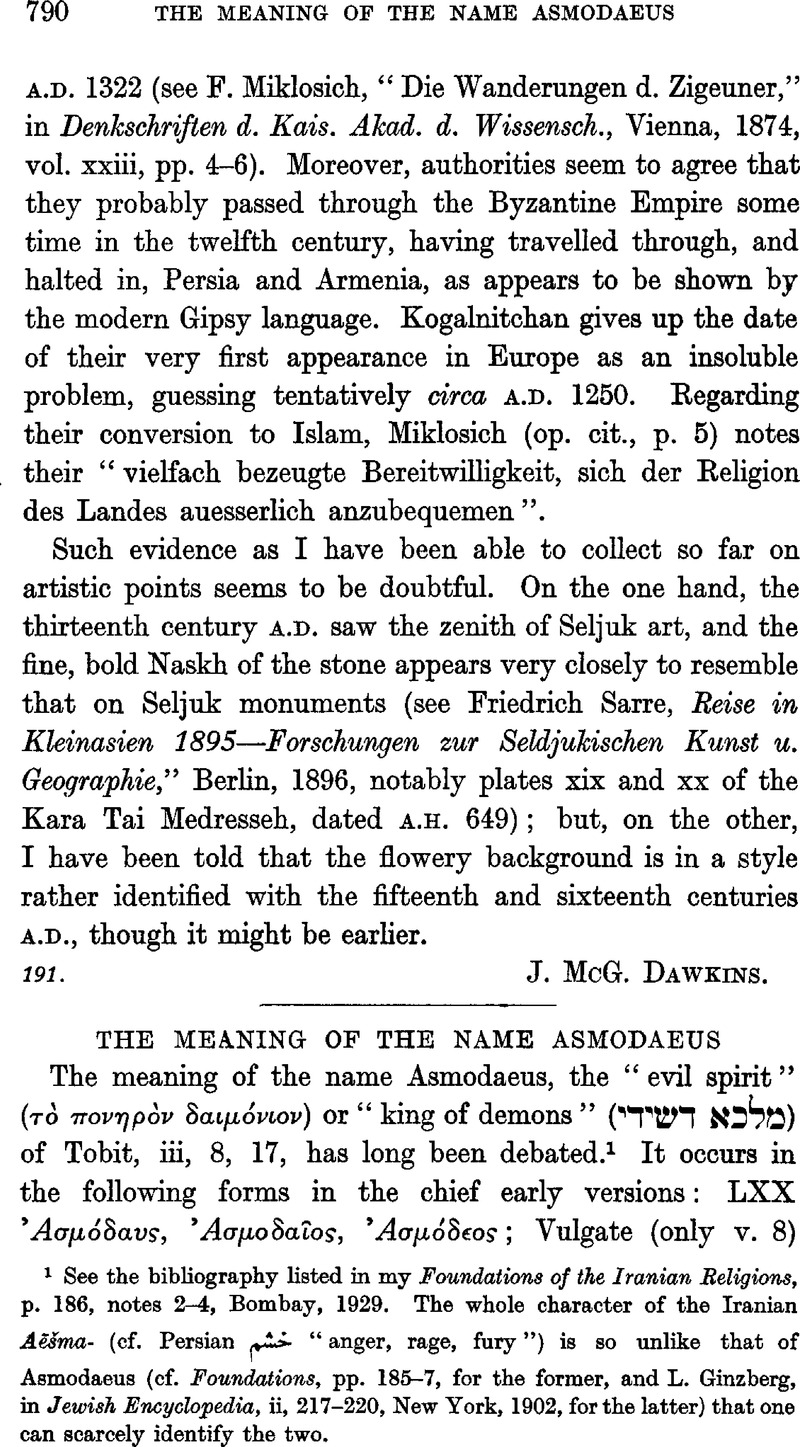No CrossRef data available.
Article contents
The Meaning of the name Asmodaeus
Published online by Cambridge University Press: 15 March 2011
Abstract

- Type
- Miscellaneous Communications
- Information
- Copyright
- Copyright © The Royal Asiatic Society 1934
References
page 790 note 1 See the bibliography listed in my Foundations of the Iranian Religions, p. 186, notes 2–4, Bombay, 1929Google Scholar. The whole character of the Iranian Aēšma- (cf. Persian ![]() “anger, rage, fury”) is so unlike that of Asmodaeus (cf. Foundations, pp. 185–7, for the former, and Ginzberg, L., in Jewish Encyclopedia, ii, 217–220, New York, 1902Google Scholar, for the latter) that one can scarcely identify the two.
“anger, rage, fury”) is so unlike that of Asmodaeus (cf. Foundations, pp. 185–7, for the former, and Ginzberg, L., in Jewish Encyclopedia, ii, 217–220, New York, 1902Google Scholar, for the latter) that one can scarcely identify the two.
page 791 note 1 As maintained by Benfey, T., Über die Monatsnamen einiger alter Völker, p. 201, Berlin, 1836Google Scholar; Haug, M., Essays … on the Parsis, 3rd ed., p. 337, note 4, London, 1884Google Scholar; Windischmann, F., Zoroastrische Studien, pp. 143–6, Berlin, 1863Google Scholar; Kohut, A., Über die jüdische Angelologie und Daemonologie in ihrer Abhängigkeit vom Parsismus, pp. 72–84, Leipzig, 1866Google Scholar; Moulton, J. H., Early Zoroastrianism, pp. 250–2, London, 1913Google Scholar.
page 791 note 2 So Scheftelowitz, I., Die altpersische Religion und das Judentum, p. 61, Giessen, 1920Google Scholar.
page 791 note 3 While daēva- almost invariably means “demon” in Iranian, its earlier signification “god” is retained in at least two Osrūšanian proper names of the ninth century, Dēvdāδ and Dēvdast (Nöldeke, T., in Zeitschrift für Indologie und Iranistik, ii [1923], 318Google Scholar; cf. Gray, L. H., in JRAS. 1927, p. 438Google Scholar, note 3). With -δεος, etc., cf. Hesychios, δευας τοὺς κκους θεος Μγοι (to be emended with de Lagarde, P., Gesammelte Abhandlungen, p. 148, Leipzig, 1866Google Scholar, to κακος).
page 791 note 4 Bartholomae, C., Altiranisches Wörterbuch, col. 221, Strasbourg, 1904Google Scholar; so also Justi, F., Handbuch der Zendsprache, p. 38, Leipzig, 1864Google Scholar (his later view, reading Aëšmō-, and supposing that it contains the Semitic name Ešmun, [Asklepios], Iranisches Namenbuch, p. 11, Marburg, 1895Google Scholar, is a distinct retrogression). For Iranian asan-, asman- “stone” in the sense of “heaven” (Persian ![]() ), see Bartholomae, col. 208, and cf. Hesychios, ἄκμων … οὐρανς.
), see Bartholomae, col. 208, and cf. Hesychios, ἄκμων … οὐρανς.
page 792 note 1 Cf. Justi, , Namenbuch, pp. 43, 117Google Scholar, and, for the second component, p. 490; Kallistos, Nikephoros (beginning of the fourteenth century), Historia ecclesiastica, xviii, 25Google Scholar (Migne, , Patrologia Graeca, cxlvii, 377Google Scholar): ΓολινδοὺΧ μρτυς … κ μγων γεγενηένη περσν, 'ΑσμοδΧ μν πατρός, μητρς δ ΜυζούΧ.
page 792 note 2 Montgomery, J., Aramaic Incantation Texts from Nippur, xii, 1, 10Google Scholar; xvi, 1, 12; xxxi, 2, 6, 9 (pp. 174, 188, 223), Philadelphia, 1913.
page 792 note 3 Gray, pp. 137–8.
page 792 note 4 Ib., p. 26.
page 792 note 5 Olufsen, O., Through the Unknown Pamirs, p. 199, London, 1904Google Scholar.




